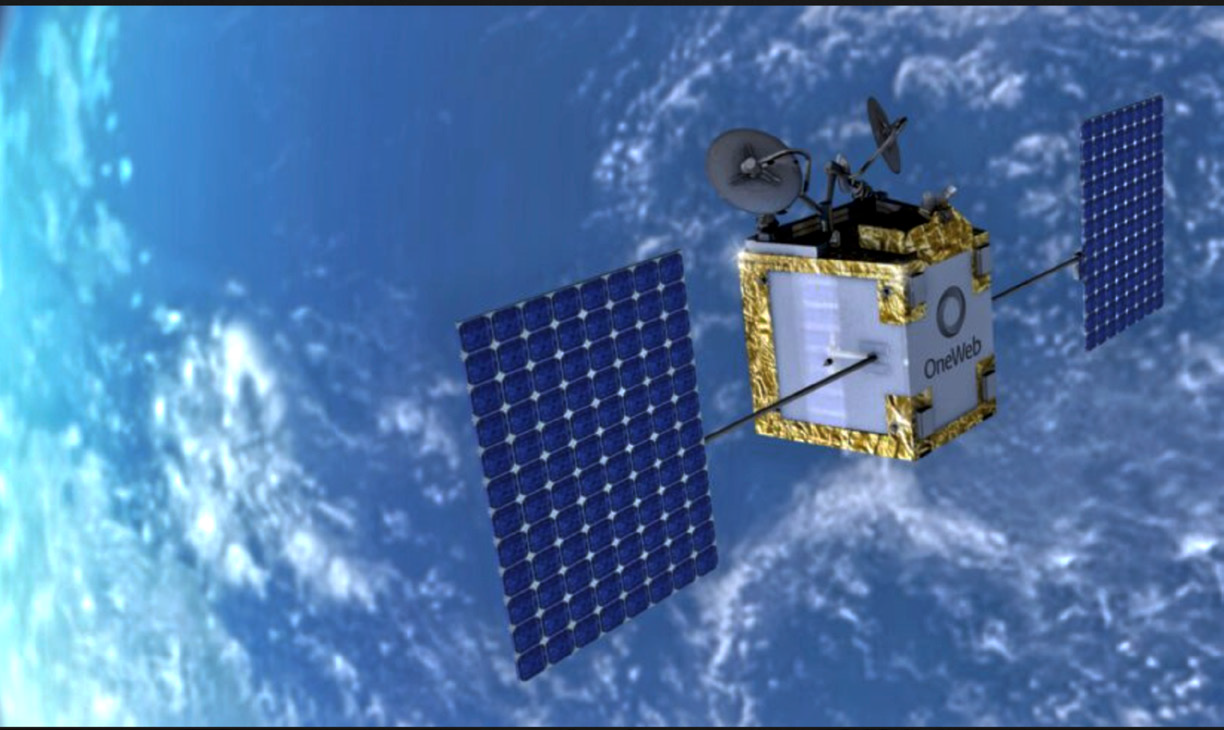Ed Slater is the Senior Vice President, Sales and Marketing at OneWeb Technologies, a leading provider of secure and commercial satellite communications connectivity for applications and wireless technologies globally. In this role, he is responsible for leading the development and implementation of the sales distribution and marketing strategy.
Mr. Slater has more than 25 years of experience in satellite communications, both as an operator and in commercial delivery, previously holding senior positions in the USAF and the commercial sector. Most recently, Mr. Slater was Senior Director of Sales at OneWeb Technologies, after previously serving as the company’s Director, Partner Development.
Mr. Slater brings a wealth of prior experience in satellite communications, government business development, partnerships and operations to OneWeb Technologies. Prior to OneWeb Technologies, he was Director, Government Aviation at OneWeb and held multiple government business leadership positions at Satcom Direct Communications, the largest provider of Inmarsat L-band services to the Department of Defense (DoD).
He has experience leading teams responsible for customer support, activations, contract management and sales, servicing all branches of DoD as well as the State Department, FBI and other Federal Agencies.
Mr. Slater retired from the USAF in 2014 as a SMSgt. as Superintendent, Air Force One Communications. During his military career, he served in the 99th Airlift Squadron, traveling the globe in support of the U.S. Vice President, cabinet members, DoD leadership and federal agencies. He also served in the Presidential Airlift Group (PAG), where he led airborne communication for U.S. Presidents Bush and Obama. While at the PAG, he ran multiple programs to modify communications and enhance the technology and capabilities of Air Force One. During his 14 years at Andrews AFB, he was qualified on 747B, C-32A/B, C-20B/H, C-37A aircraft as both an instructor and evaluator.
Mr. Slater holds a Bachelor of Science degree in Information Technology Management from American Military University.
Good day, Mr. Slater. Thanks for taking the time to offer us your insights. Would you please tell us how you initially became interested, and involved, in the satellite communications (SATCOM) industry?

Ed Slater
Ed Slater
When I was in the U.S. Air Force (USAF), I learned firsthand that ensuring our warfighter’s safety and security ultimately boils down to providing them with critical access to the data and information they require when it matters most. It became clear that communications were an essential component to any operational strategy.
I became interested in satellite communications solutions as an opportunity to help provide our military and government access to the essential connectivity, confidence and visibility that they require for successful global missions. For obvious reasons, terrestrial cellular networks were not an option in austere, contested, degraded and operationally-limited environments – and satellite communications (SATCOM) provided the infrastructure when terrestrial was unavailable.
Today, commercial SATCOM solutions not only enable this vital lifeline on the battlefield, but also help meet the demand for increased bandwidth as military technology becomes more sophisticated and requires more of it.
How did your career in the U.S. Air Force (and thank you for your service] prepare you for entry into the world of SATCOM and MILSATCOM?
Ed Slater
In the early 2000s, my military career required that I travel the globe to serve in the 99th Airlift Squadron supporting the Vice President of the United States, cabinet members, Department of Defense (DoD) leadership and federal agencies. I later served in the Presidential Airlift Group (PAG), where I was responsible for all airborne communication for the Office of the President of the United States, serving both President Bush and President Obama.

At PAG, I led multiple communication modification programs bringing new technology and capabilities to Air Force One. From the time I began my career in the USAF to my retirement to the commercial sector, it has always been clear that rapid and secure communications between military personnel and intelligence operatives is imperative, no matter the mission or the location.
Whether it be securing the travel of our Commander in Chief in the air, or the safety of our warfighters on the ground, satellites have proven imperative for global communications. And prior to the U.S. Space Force taking over, the USAF was previously in charge of procuring these communications. We understood the value of satellite communications for the military and that now translates over to the important work we do at OneWeb Technologies today.
Please explain what OneWeb Technologies encompasses and the services provided by the company.
Ed Slater
OneWeb Technologies is a leading provider of Low Earth Orbit (LEO) satellite services for the U.S. government, and its allies. Our satellite communications solutions provide accurate, rapid information to the U.S. government, which is a fundamental component of decision making on and off the battlefield.
We are committed to offering our customers more choice, and that means we take a broader and integrated approach to developing our COMSATCOM solutions. This open approach allows us to offer the best multi-orbit (geosynchronous, GEO, middle-earth orbit, MEO, and LEO) solutions that meet the U.S. DoD’s exact requirements.
Our nimble, open and customized approach to developing and tailoring solutions makes OneWeb Technologies highly attractive for mission-critical applications – be it for connecting warfighters, enabling broadband and IoT connectivity to crewed and uncrewed platforms.
What is the firm’s relationship with Eutelsat OneWeb?
Ed Slater
OneWeb Technologies is the U.S. proxy company to OneWeb and a leading provider of LEO satellite services for the U.S. government, and its allies, in the rapidly evolving field of satellite communications. OneWeb Technologies was specifically formed to meet the demand for secure satellite communications here in the U.S., and as a wholly owned subsidiary of our foreign-based company, we can work directly with U.S. agencies.
Recognizing that our customers’ needs are unique, OneWeb Technologies customizes capabilities on top of OneWeb’s global LEO satellite constellation to offer the U.S. government and its allies the secure, robust and resilient connectivity they require. We are focused on providing differentiated low-latency, high-throughput, communications meeting the demanding expectations of government users.
Now, with the recent announcement of the merger of OneWeb and Eutelsat, OneWeb Technologies can expand the capabilities that we are able to offer our customers. We are very excited about the possibilities of what we will soon be able to offer.
Why should the U.S. Government (USG) and the nation’s allies work with OneWeb Technologies? What pluses does your company offer over competing firms for USG business?
Ed Slater
OneWeb Technologies’ focus is 100 percent on the government market and supporting our partners. The investments we are making to advance our low- latency LEO technologies will benefit governments greatly, providing them access to secure, robust, and resilient new connectivity capabilities faster than they can do themselves.
Government and commercial collaboration is certainly not new in the satellite industry, but OneWeb Technologies takes a unique approach to the delivery of our secure and trusted services. The U.S. government is our number one priority. We view ourselves as a partner of the government and invested in making their objectives ours.
OneWeb Technologies is committed to transforming the communications landscape and enabling connectivity data security, velocity, and surety solutions that meet the evolving needs of government users. OneWeb Technologies is also committed to developing and delivering customized solutions that fit its customers’ precise needs.
As mentioned, this includes the ability to offer multi-orbit satellite services (LEO, MEO and GEO) so that our customers can benefit from added resilience and redundancy to ensure they are always connected. This makes OneWeb Technologies highly attractive for mission-critical applications, be it for connecting warfighters, enabling broadband and IoT connectivity to manned and unmanned platforms.
What channels enable the military/agency/government (MAG) to access OneWeb Technologies’ services?
Ed Slater
OneWeb Technologies was awarded the U.S. Space Force’s p-LEO contract. Being a prime contractor opens up the opportunity for us to help agencies — such as the Air Force, Navy, and Army — to take advantage of our innovative SATCOM technologies and solutions. In addition to being a p-LEO prime contractor, OneWeb Technologies is also a LEO distribution partner to several of the GEO operators that were also awarded on the p-LEO contract.
In addition, we believe in the power of collaboration and that integrated solutions are more resilient and powerful. To that end, OneWeb Technologies has completed 16 distribution agreements with partners from around the satellite industry, including GEO satellite operators, system integrators, antenna manufactures and small businesses.

What is Proliferated Low Earth Orbit (p-LEO)? Is OneWeb Technologies engaged in this technology? If so, why is this significant and what routes will the company take to support p-LEO?
Ed Slater
The USSF’s Commercial Satellite Communications Office (CSCO) overhauled its procurement procedure for commercial satellite communications services (COMSATCOM), replacing the system with a model that consolidates both provider contracts and military customer requirements. As mentioned, this new model allows the CSCO to consolidate contracts and gives military agencies a more holistic view of available COMSATCOM providers’ capabilities. This program enables government users the ability to act more rapidly and offers flexible access to customized IT solutions and emerging technologies from a diverse pool of commercial satellite providers.
Our award as a prime p-LEO contractor establishes a “pre-competition” award of sorts and is a significant milestone for OneWeb Technologies making us a trusted partner to the U.S. government. From our perspective, this means less competition, and opens more opportunities for us to work with the U.S. Space Force in connecting our troops.
Now, as a prime contractor in the p-LEO program, OneWeb Technologies is able to add customized capabilities on top of OneWeb’s constellation to offer the U.S. government and the secure connectivity they require.
What are some of the future communications needs of the U.S. Department of Defense (DoD) and the U.S. Space Force (USSF)? What can we expect from commercial MILSATCOM companies to meet these future requirements?
Ed Slater
Government demand for satellite broadband continues to increase as satellite communications have become an even more critical element of the US military’s strategy. The shift in the U.S. DoD’s approach to their COMSATCOM procurement process is a key indication of this. This means our forces can benefit from the innovation of our commercial systems, without the upfront investment and ultimately our warfighters have the access to the crucial connectivity, data and information that they require on the battlefield.
The type of SATCOMs needed by the U.S. military is also changing; it is shifting to more robust, resilient, and lower-latency systems to support autonomy and faster decision cycles. Plus, our military users expect their devices and networks to work just as fast as they do outside of government. It used to be that we would take government technologies and implement them commercially, and now it is the government that is benefiting from the speed and power of commercial innovation.
The company has successfully engaged in several successful demonstrations for government agencies. Please tell us about these events and the agency’s response to these exercises?
Ed Slater
Recently, our team attended the Shadow Warrior Tech Summit, presenting our capabilities to Joint and Special forces units, along with demos of partner Kymeta Corporation’s U8 communications-on-the-move (COTM) offering as well as the OneWeb FoldSat LEo Ku OW Mil foldable and person-portable user terminal manufactured by Inster Group.
We also collaborated with Kymeta and Viasat to demonstrate the seamless integration of a multi-orbit, LEO and GEO solution to deliver high-bandwidth, reliable communications for our U.S. Marine Corps. The demo took place during the U.S. Marine Corps’ 1st Air Naval Gunfire Liaison Company (ANGLICO) “Exercise Red Flag,” and showcased that interoperability across multiple plans is possible. This type of integration is a primary component of the 1st ANGLICO’s PACE plan, and a growing expectation from the U.S. military. That demo came on the heels of the successful conclusion of several demonstrations with MITRE and the Department of the Air Force’s Program Executive Office for Command, Control, Communication and Battle Management (PEO C3BM) during the U.S. Indo-Pacific Command “Exercise Northern Edge” in Alaska at the Joint Pacific-Alaska Range Complex (JPARC).
These demonstrations were well received and we were pleased to have the opportunity to showcase these powerful new LEO connectivity capabilities for military operations – while on-the-move or stationary.
When you review your career in this industry, what missions or projects truly bring a sense of satisfaction to you?
Ed Slater
Not sure I could name just one project, as I am fortunate to have had an incredible career.
A couple of highlights that stand out to me include my first duty station in the USAF, where I was a Communications System Operator on JSTARS. When I arrived at JSTARS, the Wing hadn’t even achieved Initial Operational Capability. I was able to be a part of the process to demonstrate the aircraft,bcrews, maintenance, and support could deploy and execute the mission. This is an experience few people get to be part of, and I am proud to have been one of those people.
The Air Force One mission was an incredible experience with hardworking, focused, mission-driven airmen. It’s difficult to put into words what its truly like. The pride of the PAG I think is unmatched, the “No Fail Mission” really changes the way you think and approach tough and complex problems.

In my civilian career, OneWeb was an amazing experience. I initially joined OneWeb in 2019 and experienced both the lows and highs of bringing that constellation to market. One of the highs of course was the Trustcomm acquisition, which created OneWeb Technologies where I sit today.
More recently, the merger of OneWeb and Eutelsat creates an opportunity for OneWeb Technologies to strengthen the capabilities. Now the pace is picking up, satellites are up, more terminals are coming to market and expanded coverage is rolling out.
This is an amazing time to be in the satellite industry and to be part of bringing a capability to market that will support the U.S. warfighter.
onewebtechnologies.net
OneWeb Technologies Inc. is a commercial satellite communications (SATCOM) services provider, offering resilient fixed and mobile solutions to the U.S. government and its allies. As OneWeb’s U.S. proxy organization, OneWeb Technologies has access to an operational, robust 600+ global low- earth orbit (LEO) satellite constellation, and offers a customer-first, adaptable and consultative approach to developing customer solutions. The company provides Committed Information Rates (CIR), contracted Service Level Agreements (SLAs), a 24/7 Managed Service Operation Center (MSOC), and offers traffic prioritization through a Global Access Network (GAN) that meets or exceeds U.S. government security mandates.

